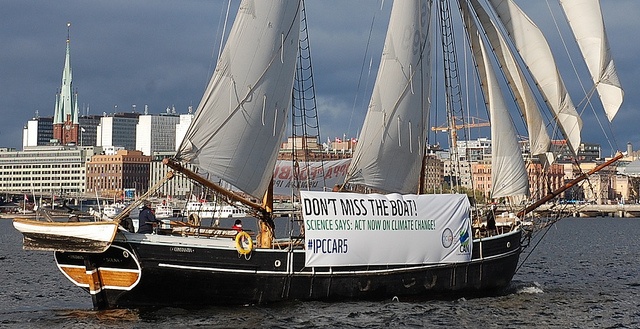Political commitments on climate action, to the extent they exist, are usually pitched in terms of targets and timelines. B.C., for example, has a legislated target of 33 per cent below 2007 levels by 2020; Canada’s official target is a 17 per cent reduction by 2020 relative to 2005 levels. Neither target will be met under status quo policy, which is, de facto, to extract as much carbon and put it in the atmosphere as possible.
In recent years, the concept of a carbon budget has come to the fore. That is, not just targets for some future date but a total amount of carbon that can be released before we cross dangerous thresholds; typically, more than 2 degrees C of temperature increase relative to pre-industrial times. In a CCPA paper released in March, we considered the concept of a carbon budget for Canada and its implications for the country’s vast reserves of fossil fuels, and concluded that most of our reserves needed to stay below ground.
The new IPCC report for the first time sets out a carbon budget. Here is the relevant paragraph from the Summary for Policy-makers:
Limiting the warming caused by anthropogenic CO2 emissions alone with a probability of >33 per cent, >50 per cent, and >66 per cent to less than 2°C since the period 1861–1880, will require cumulative CO2 emissions from all anthropogenic sources to stay between 0 and about 1560 GtC, 0 and about 1210 GtC, and 0 and about 1000 GtC since that period respectively. These upper amounts are reduced to about 880 GtC, 840 GtC, and 800 GtC respectively, when accounting for non-CO2 forcings as in RCP2.6. An amount of 531 [446 to 616] GtC, was already emitted by 2011.
So for a two-thirds probability of not exceeding 2 degrees, the world’s carbon budget is 1000 billion tonnes of carbon (gigatonnes or Gt C) less 200 Gt C for other non-CO2 emissions (like methane) and less the 531 Gt C already released as of 2011, which leaves us with 269 Gt C. Translated into CO2, that is 987 Gt CO2. For a 50 per cent chance (a coin-toss for exceeding 2 degrees), we can emit up to 1,134 Gt CO2e. For context, annual emissions globally from fossil fuel combustion are about 33 Gt CO2. So if we add emissions for 2012 and 2013, the carbon budget drops to 1,068 Gt CO2 for 50 per cent odds, and 921 Gt CO2 for 66 per cent odds.
[Aside: Some reports on this concept make a mathematical error, confusing carbon with carbon dioxide. Most discussion in terms of carbon dioxide (CO2) because that is the main gas from the combustion of fossil fuels that is warming the planet, but many scientists still use carbon (C). The mass of carbon dioxide is 3.67 times that of carbon (see discussion here), and sometimes people fail to convert. In what follows I will stick to CO2 instead of C as that makes more intuitive sense.]
The carbon budget analysis in our carbon liabilities report was based on a Potsdam Institute study, which had tighter parameters. To be prudent and precautionary, we used an 80 per cent chance of staying below 2 degrees, amounting to 500 Gt CO2, but noted a 50 per cent chance would be 1,000 Gt CO2.
What’s this mean for Canada? Using the 500 Gt budget, we estimated a Canadian carbon budget of 9 Gt based on share of global GDP, and 2.4 Gt based on share of population. That said, I inflated the plausible upper limit to 20 Gt because of Canada’s role as a fossil fuel exporter. But even if we take the biggest carbon budget of 20 Gt, 78 per cent of proven reserves and 89 per cent of proven-plus-probable reserves would need to stay underground.
The basic problem does not really go away if we use higher numbers from the IPCC report, so if we go with the (weaker) 50-50 chance (1068 Gt), Canada would be allocated a 5.1 Gt carbon budget based on population, and 19.2 Gt based on share of GDP. Even though this is very conservative, assume Canada’s shrewd negotiators were able to secure a 40 Gt carbon budget, more than double our share of GDP, and we still have the result that 56 per cent of proven fossil fuel reserves (which are equivalent to 91.4 Gt) and 77 per cent of proven-plus-possible reserves need to stay below ground.
No matter how you slice it, Canada has a carbon bubble on its hands — if the world heeds warnings from bodies like the IPCC.
Photo: CAN Europe/flickr



